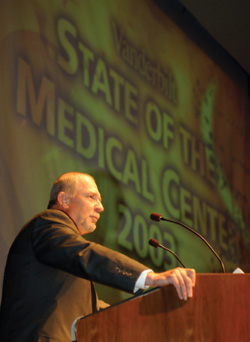
Dr. Harry R. Jacobson talks to the crowd at Langford Auditorium Tuesday afternoon during the 2003 State of the Medical Center address. (photo by Dana Johnson)
Jacobson outlines ‘truths’ of VUMC
There are certain “self evident truths” about Vanderbilt University Medical Center that cannot be denied: demand for services is rising, hospital admissions are steadily increasing, and it’s hard to find a place to park.
Dr. Harry R. Jacobson, vice chancellor for Health Affairs, outlined these and several other “truths” at the 2003 State of the Medical Center address Tuesday afternoon in Langford Auditorium.
“It’s been a great year for the medical center and a privilege for me to have this position and work with people like you,” Jacobson told the crowded auditorium.
Jacobson noted several signposts of progress in the past year:
• Vanderbilt was selected as one of 300 finalists in Fortune magazine’s Top 100 Places to Work. Criteria includes employees’ ideas of respect, credibility, fairness, pride and camaraderie in association with the work environment. Jacobson acknowledged, “This is a great accolade, but we still have a long way to go to be the best place to work.”
•Vanderbilt continues to be recognized as a leader in health care delivery and training. Jacobson reminded the audience that in 2002 VUH earned a place on the “honor roll” of the nation’s best hospitals in rankings released in July by U.S. News and World Report — the first time in the 13-year history of the magazine’s annual survey that Vanderbilt University Hospital and The Vanderbilt Clinic have achieved the top tier.
• The Leapfrog Group, a consortium of Fortune 500 companies and other large private and public health care purchasers, commended Vanderbilt University Hospital for key patient safety measures. The National Quality Forum has chosen Vanderbilt to assist it in developing a set of quality standards to be used to measure hospital performance.
• Hospital admissions have risen throughout the past years, increasing from 1997’s 28,496 to last year’s 32,960. More than 34,000 admissions are expected for 2003.
Jacobson described efforts to meet this increasing patient demand, including the addition of 24 beds across VUH inpatient units; clinics working to make better use of Thursday and Friday afternoons, with certain clinics considering expanded hours to ease the outpatient mid-week bottleneck; the OR beginning routine weekend operation on a limited basis; and the ED evaluating whether to extend hours of its fast-track program, which allows patients with minor injuries to be seen more quickly. These are other recommendations comprise the “Over-the-Wall” initiatives.
“These initiatives are rapid cycle changes in the way we do business — barriers that have kept us from meeting our goals,” Jacobson said.
Research Enterprise flourishes
As the clinical side continues to flourish, so does the research enterprise, according to Jacobson. The research enterprise performance saw a 30 percent growth in the first quarter of 2003. Projections for 2003 place VUMC three years ahead of schedule in funding the research enterprise. “This is a wonderful tribute to our research faculty and great recruits in the past year,” Jacobson said.
Vanderbilt, for the first time, was among the top 20 U.S. academic medical centers in terms of NIH funding, receiving more than $137 million from the NIH last year. “This is a phenomenal,” Jacobson said of VUMC’s growth and ranking. “We also expect to move up a few more places in 2003.”
Vanderbilt is also one of the country’s leading training centers, attracting top students throughout the disciplines. Last year, more than 2,000 students, fellows and residents were trained at the medical center. At Vanderbilt only the College of Arts and Science has more students than the medical center.
Jacobson lauded the goal of Dr. Steven G. Gabbe, dean of the School of Medicine, for Vanderbilt to be ranked in the top 10 U.S. medical schools by 2010 in terms of top students, NIH funding, best hospital, and a leader in royalty income. And he praised the School of Nursing’s initiatives with Fisk and Lipscomb to train additional nurses while increasing diversity.
Key elements of the academic strategic plan include growing basic and clinical research; recruiting top students and faculty; rewarding excellence in teaching; expanding the Meharry-Vanderbilt Alliance; and increasing financial resources through philanthropy, technology transfer and clinical enterprise.
Building update
Another “truth” outlined by Jacobson was the ever-present construction scene at VUMC.
The Monroe Carell Jr. Children’s Hospital at Vanderbilt is scheduled to open in November. The outpatient tower at VCH will open in summer 2004. Medical Center East II, including the Vanderbilt Bill Wilkerson Center and the Musculoskeletal Institute will also open in fall 2003.
The Vanderbilt-Eskind Diabetes Center, a comprehensive care center that will see 40,000 patients each year, is expected to be completed by July 2004. The center will be located at the east end of Capers Garage.
These and other construction projects at Vanderbilt obviously require huge amounts of money; however, according to Jacobson, this has been challenge in the current market.
Charitable gifts are down considerably from 2002, but Jacobson is hopeful. “I’m optimistic that the capital campaign will pick up when the market picks up.”
Jacobson sees people and programs as the cornerstone of VUMC. “We have to invest in our people and programs to expand our research enterprise,” he said. “Our goal of being a top 10 institution isn’t just a pipe dream. We can do this.”













